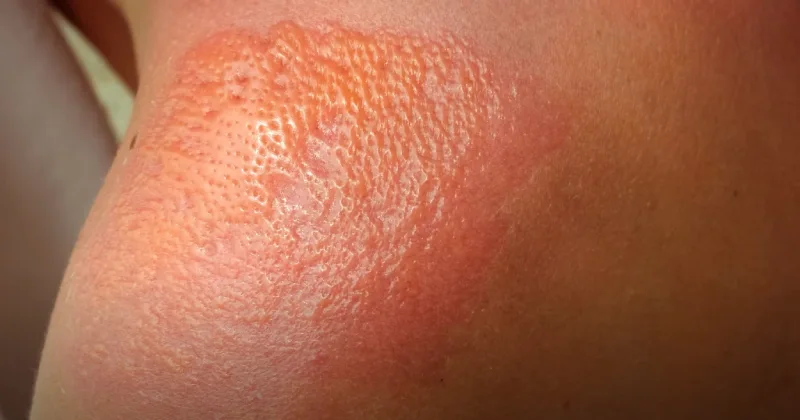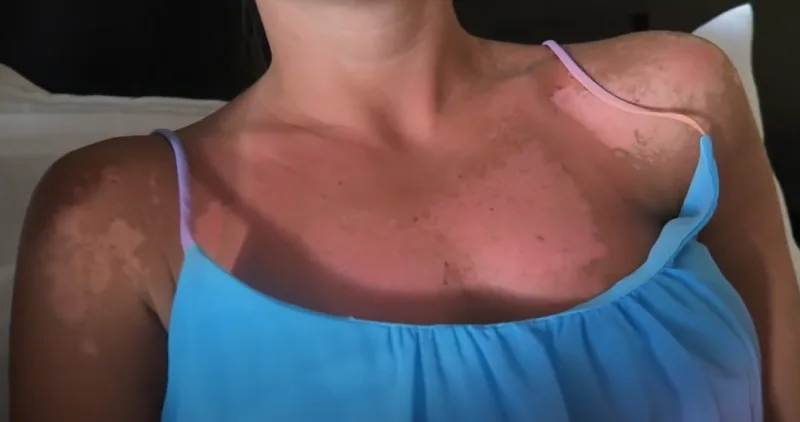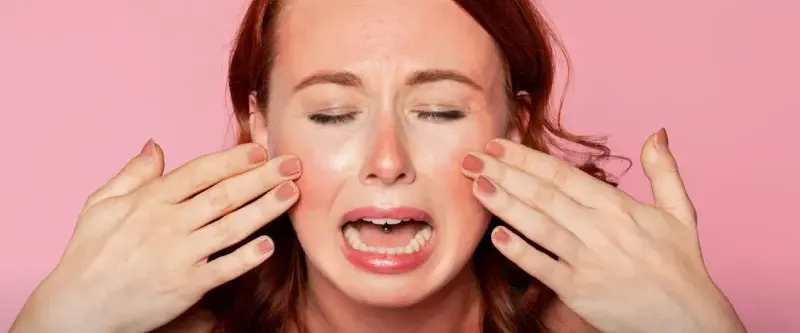Blistering indicates severe sunburn, where UV light harms the skin surface, causing serum to leak onto the skin when there is significant damage. Unless there are blisters on a person’s skin, he or she probably has a first degree burn, which is accompanied by redness, tenderness, and light peeling of the skin.
Sunburn blisters can last for a week or more depending on the severity of the UV damage and how deep it penetrated the skin.
Deeper damage, as seen with sunburn blisters, may take longer to heal compared to surface-level sunburns. In general, expect sunburn blisters to persist for a week or possibly longer.
This blog post delves into the 9 factors influencing cyclists’ sunburn blister duration. It further discusses the impacts, preventive measures, and treatment choices for sunburn blisters among cyclists.
How Long Do Sunburn Blisters Last For Cyclist: Total 41 Factors

Factors that affect sunburn blister duration can help cyclists better prepare and manage their skin health. Here, we delve into the key elements that determine how long these blisters last.
Severity of the Sunburn
The severity of a sunburn significantly affects the duration of sunburn blisters:
- Mild Sunburns: Typically result in minor redness and discomfort, with blisters healing within a few days.
- Moderate Sunburns: Cause more pronounced redness, pain, and swelling, with blisterstaking up to a week to heal.
- Severe Sunburns: Characterized by intense pain, significant blistering, and potential systemic symptoms like fever. Several weeks may be needed for healing and medical intervention.
Skin Type and Sensitivity
Individual differences in skin type and sensitivity also play a crucial role:
- Fair Skin: Cyclists with fair complexions tend to suffer severe sunburns and prolonged blistering.
- Sensitive Skin: Some people have more intense reactions and longer healing times.
- Darker Skin Tones: While less prone to severe sunburns, individuals with darker skin tones can still develop blisters that may take time to heal.
Environmental Conditions
Environmental factors can influence the duration of sunburn blisters:
- UV Index: Higher UV index levels increase the risk of severe sunburns and longer-lasting blisters.
- Humidity: High humidity can exacerbate discomfort and impede the healing process, while moderate humidity levels may aid in faster recovery.
- Temperature: Hot and cold temperatures can impede skin recovery by either aggravating the blisters or slowing down the healing process.
Sunburn Blisters for Cyclists: 11 Typical Duration

Understanding the timeline for sunburn blisters can help cyclists manage their recovery process more effectively. Here, we explore the progression from initial symptoms to full recovery.
Initial Symptoms and Formation
The first signs of sunburn blisters appear shortly after excessive sun exposure:
- Redness and Pain: Typically begin within a few hours of exposure.
- Blister Formation: Small, fluid-filled blisters may appear within 6-12 hours, when the sunburn is severe.
- Swelling and Sensitivity: Affected areas may become swollen and highly sensitive to touch.
Peak and Healing Phases
Sunburn blisters undergo distinct phases during the healing process:
Peak Phase:
- Blisters Reach Maximum Size: Usually within 24-48 hours. During this time, blisters are most painful and prone to bursting.
- Risk of Infection: Open blisters are susceptible to infection, requiring careful management.
Healing Phase:
- Blisters Begin to Dry Out: The fluid inside blisters starts to be reabsorbed by the body, generally within 3-5 days.
- Peeling: The top layer of dead skin may peel away, revealing new skin underneath.
- Itching and Minor Discomfort: Common as new skin forms.
When to Expect Full Recovery
The overall recovery time for sunburn blisters varies based on severity and individual factors:
- Mild Blisters: Typically heal within 5-7 days without complications.
- Moderate Blisters: May take up to 10-14 days, with proper care and absence of infection.
- Severe Blisters: Can require several weeks to fully heal, with potential need for medical treatment.
Sunburn Blisters on Cycling Performance: 7 Impact
Sunburn blisters can significantly impact a cyclist’s performance, both in the short term and long term. Understanding these effects can help cyclists take appropriate measures to mitigate their impact.
Short-Term Effects
In the short term, sunburn blisters can affect a cyclist’s performance in several ways:
- Pain and Discomfort: Blisters can cause intense pain and discomfort, making it difficult to maintain usual cycling positions and movements.
- Reduced Mobility: Swelling and sensitivity can limit the range of motion, affecting pedaling efficiency and overall performance.
- Dehydration Risk: Sunburn can exacerbate dehydration, a common issue for cyclists, further impacting endurance and stamina.
- Distraction: The persistent pain and irritation from blisters can distract from focusing on the ride, increasing the risk of accidents.
Long-Term Consequences
The long-term consequences of sunburn blisters can also be significant:
- Skin Damage: Repeated sunburns and blistering damage the skin over time, causing premature aging and an increased risk of skin cancer.
- Infection and Scarring: Severe blisters are prone to infection, which can lead to scarring and prolonged healing times, potentially affecting future performance.
- Psychological Impact: Chronic pain and the fear of recurrent blisters may lead to anxiety and reduced confidence, impacting a cyclist’s mental readiness and performance.
Sunburn Blisters And Cyclists: 14 Prevention

Preventing blisters caused by sunburn is particularly important for cyclists who spend extended periods under the sun. Here are some effective strategies to help safeguard your skin and ensure a more comfortable ride.
Effective Sunscreen Application Techniques
Proper sunscreen application is your first line of defense against sunburn blisters:
- Choose the Right Sunscreen: Opt for one with an SPF of at least 30.
- Apply Generously: Use about 1 ounce (a shot glass full) to cover all exposed skin.
- Cover All Areas: Don’t forget often-missed spots like the ears, back of the neck, and tops of the feet.
- Reapply Regularly: Reapply every two hours, or more frequently if sweating heavily or after swimming.
- Use Lip Balm with SPF: Protect your lips from sun damage with a lip balm that includes SPF.
Protective Clothing for Cyclists
Wearing the right clothing can provide an additional layer of protection against harmful UV rays:
- Long-Sleeved Jerseys: Opt for lightweight, long-sleeved jerseys made from UV-protective fabric.
- Cycling Gloves: Choose gloves that cover the back of your hands, which are often exposed to the sun.
- UV-Protective Sunglasses: Protect your eyes and the delicate skin around them with UV-blocking sunglasses.
- Cycling Caps and Helmets: Use a cap or helmet with a visor to shield your face and scalp.
Timing Your Rides During Peak Sun Hours
Strategic timing can help minimize sun exposure and reduce the risk of sunburn blisters:
- Early Morning Rides: Plan your rides in the early morning when UV radiation levels are lower.
- Late Afternoon Rides: Consider cycling in the evenings or late afternoons to avoid peak sun intensity.
- Check the UV Index: Use a weather app to monitor the UV index and plan your rides accordingly.
- Post-Ride Cool Down: Take a cool shower after riding in the sun to soothe your skin.
- Adequate Sleep: Getting enough sleep will support your body’s natural healing processes.
Sunburn Blisters on Cyclists: 14 Treatment
Effective treatment of sunburn blisters is crucial for cyclists to ensure a swift and comfortable recovery. Here’s a comprehensive guide on how to manage and treat sunburn blisters, from immediate first aid to seeking medical attention.
Immediate First Aid Steps
Taking prompt action can mitigate the severity of sunburn blisters and accelerate the healing process:
- Cool the Skin: As soon as you notice sunburn, take a cool (not cold) shower or use a damp, cool cloth on the affected area to reduce skin temperature and soothe irritation.
- Avoid Popping Blisters: It is dangerous to pop blisters as they can lead to infection. Allow them to heal naturally.
- Stay Hydrated: Drink plenty of water to stay hydrated, which helps your skin heal more efficiently.
- Apply Aloe Vera or Moisturizing Lotion: Use an aloe vera gel or a gentle moisturizing lotion to soothe the skin and add moisture.
- Protect the Area: Cover blisters with a sterile, non-stick bandage to protect them from friction and further irritation.
Home Remedies for Relief

Several home remedies can provide additional relief and support the healing process:
- Oatmeal Baths: Adding colloidal oatmeal to a lukewarm bath can help reduce itching and inflammation.
- Cool Compresses: Rubbing a cool, damp cloth over blisters can alleviate pain and reduce swelling.
- Pain Relievers: Taking ibuprofen or acetaminophen help to manage pain and reduce inflammation.
- Hydrocortisone Cream: Applying a 1% hydrocortisone cream can help reduce redness and swelling. Avoid using it on open blisters.
- Stay Out of the Sun: Avoid further sun exposure while your skin heals to prevent additional damage.
When to Seek Professional Medical Help
In some cases, professional medical intervention is necessary to ensure proper healing of sunburn blisters:
- Severe Blisters: If the blisters cover a large area of skin or are extremely painful, seek medical advice.
- Signs of Infection: Indicators such as increased redness, warmth, pus, or red streaks around the blisters require immediate medical attention.
- Fever or Chills: If you experience systemic symptoms like chills or fever, it may indicate a more serious condition requiring prompt medical care.
- Persistent Symptoms: If blisters do not improve within a week or worsen despite home treatment, consult a healthcare professional.
Conclusion
As cyclists, our passion lies in the freedom of the open road, the wind in our hair, and the warmth of the sun on our skin. Long-term sun exposure can result in painful sunburn blisters.
By delving into the causes and duration of these blisters and adopting good habits such as consistent sunscreen use, donning protective clothing, timing our rides wisely, and embracing proper rest and recovery techniques, we can ensure that the sun remains a companion rather than a foe.
It’s not merely about riding faster or longer; it’s equally about riding with intelligence and safety in mind. So, let’s prepare ourselves, apply that sunscreen, and embark on our journey without the hindrance of sunburn blisters.
FAQs
Do I Need To Cover A Burn Blister Overnight?
Yes, it is recommended that a burn blister be covered overnight with a clean bandage to protect the skin. Make sure the bandage is wrapped loosely to avoid putting pressure on the burned area. This will help reduce pain, protect the blistered skin, and promote healing.


